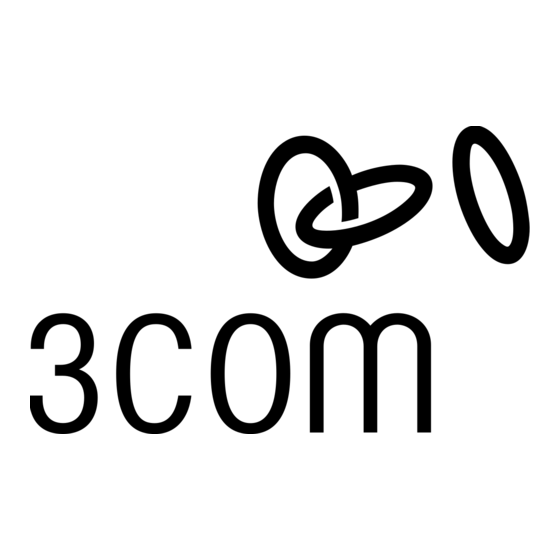3Com 2126-G - Baseline Switch Gebruikershandleiding - Pagina 6
Blader online of download pdf Gebruikershandleiding voor {categorie_naam} 3Com 2126-G - Baseline Switch. 3Com 2126-G - Baseline Switch 10 pagina's. Baseline switches
Ook voor 3Com 2126-G - Baseline Switch: Producthandleiding (13 pagina's), Gegevensblad (2 pagina's), Gegevensblad (2 pagina's), Gegevensblad (2 pagina's), Gegevensblad (4 pagina's)

Schweiz
Dieser Stromstecker muß die SEV/ASE 1011Bestimmungen
■
einhalten.
Europe
Das Netzkabel muß vom Typ HO3VVF3GO.75
■
(Mindestanforderung) sein und die Aufschrift <HAR> oder
<BASEC> tragen.
Der Netzstecker muß die Norm CEE 7/7 erfüllen
■
("SCHUKO").
I
NFORMACIÓN DE
Lea la sección 'Información de seguridad importante'
detenidamente antes de instalar la unidad
ADVERTENCIA: La instalación y la extracción de la unidad sólo
debe llevarla a cabo personal cualificado.
Si instala la unidad Switch en una pila con unidades Baseline, el Switch
se debe instalar debajo de las unidades Hub más estrechas.
La unidad debe estar conectada a tierra para garantizar el
cumplimiento de las normas de seguridad.
No conecte la unidad a una toma de CA (fuente de alimentación) sin
conexión a tierra.
El acoplador del equipo (es decir, el conector para la unidad y no la
toma de la pared) debe tener una configuración que se adapte a una
entrada del equipo EN60320/IEC320.
El enchufe debe estar cerca de la unidad y ser de fácil acceso. La única
forma de interrumpir la alimentación de la unidad es desconectando el
cable eléctrico de la toma de corriente.
Esta unidad funciona en condiciones de voltaje extrabajo de seguridad
(SELV), de conformidad con la norma IEC 60950. Las condiciones de
T
ECHNICAL
Related Standards
The 3Com Baseline Switch 2126-G has been designed to the
following standards:
Functional
ISO 8802-3, IEEE 802.3 (Ethernet), IEEE 802.3u (Fast
Ethernet), IEEE 802.3ab and IEEE 802.3z (Gigabit
Ethernet), IEEE 802.3x (Flow Control), IEEE 802.1D 1998
(Bridging)
Safety
UL 60950, EN 60950, CSA 22.2 No. 60950, IEC 60950
EMC Emissions
EN 55022 Class A, FCC Part 15 Subpart B Class A,
ICES-003 Class A, VCCI Class A, AS/NZS 3548 Class A
Immunity
EN 55024
Environmental
Operating Temperature
0–40 °C (32–104 °F)
Humidity
10–95% (non-condensing)
Physical
Width
440 mm (17.3 in.)
Depth
173 mm (6.8 in.)
R
EGULATORY
FCC Statement
This equipment has been tested and found to comply with the
limits for a Class A digital device, pursuant to part 15 of the FCC
rules. These limits are designed to provide reasonable protection
against harmful interference when the equipment is operated in
a commercial environment. This equipment generates, uses and
can radiate radio frequency energy and, if not installed and used
in accordance with the instructions, may cause harmful
interference to radio communications. Operation of this
equipment in a residential area is likely to cause harmful
interference to radio communications, in which case the user will
be required to correct the interference at their own expense.
S
EGURIDAD
.
I
NFORMATION
N
OTICES
I
MPORTANTÉ
funcionamiento sólo se mantendrán si el equipo al que esté conectada
la unidad también cumple los requisitos SELV.
Sólo para Francia y Perú.
Esta unidad no puede recibir corriente de fuentes IT
suministro de corriente son de tipo IT, esta unidad debe recibir 230 V (2P+T) a
través de un transformador aislador con relación 1:1, con el punto de
conexión secundario etiquetado como neutro conectado directamente a tierra.
†
Impédance à la terre
El cable eléctrico
Debe estar homologado para el país donde se utilice:
Europa
La toma de alimentación debe cumplir la norma CEE 7/7
■
("SCHUKO").
El cable de la red eléctrica debe tener la marca <HAR> o
■
<BASEC> y ser de tipo H03VVF3g0.75 (mínimo).
Height
44 mm (1.7 in.) or 1U
Weight
1.6 kg (3.52 lb)
Mounting
Free standing, or 19 in. rack mounted using the
mounting kit supplied
Electrical
Power Inlet
AC Line Frequency
Input Voltage
Current Rating
Maximum Power
Consumption
Maximum Power
Dissipation
Information to the User
If this equipment does cause interference to radio or television
reception, which can be determined by turning the equipment
off and on, the user is encouraged to try to correct the
interference by one or more of the following measures:
Reorient the receiving antenna.
Relocate the equipment with respect to the receiver.
Move the equipment away from the receiver.
Plug the equipment into a different outlet so that equipment
and receiver are on different branch circuits.
If necessary, the user should consult the dealer or an experienced
radio/television technician for additional suggestions. The user
6
†
. Si las fuentes de
IEC 320
50/60 Hz
100–240 VAC
1 Amps (maximum)
12.474 watts
42.56 BTU/hr
